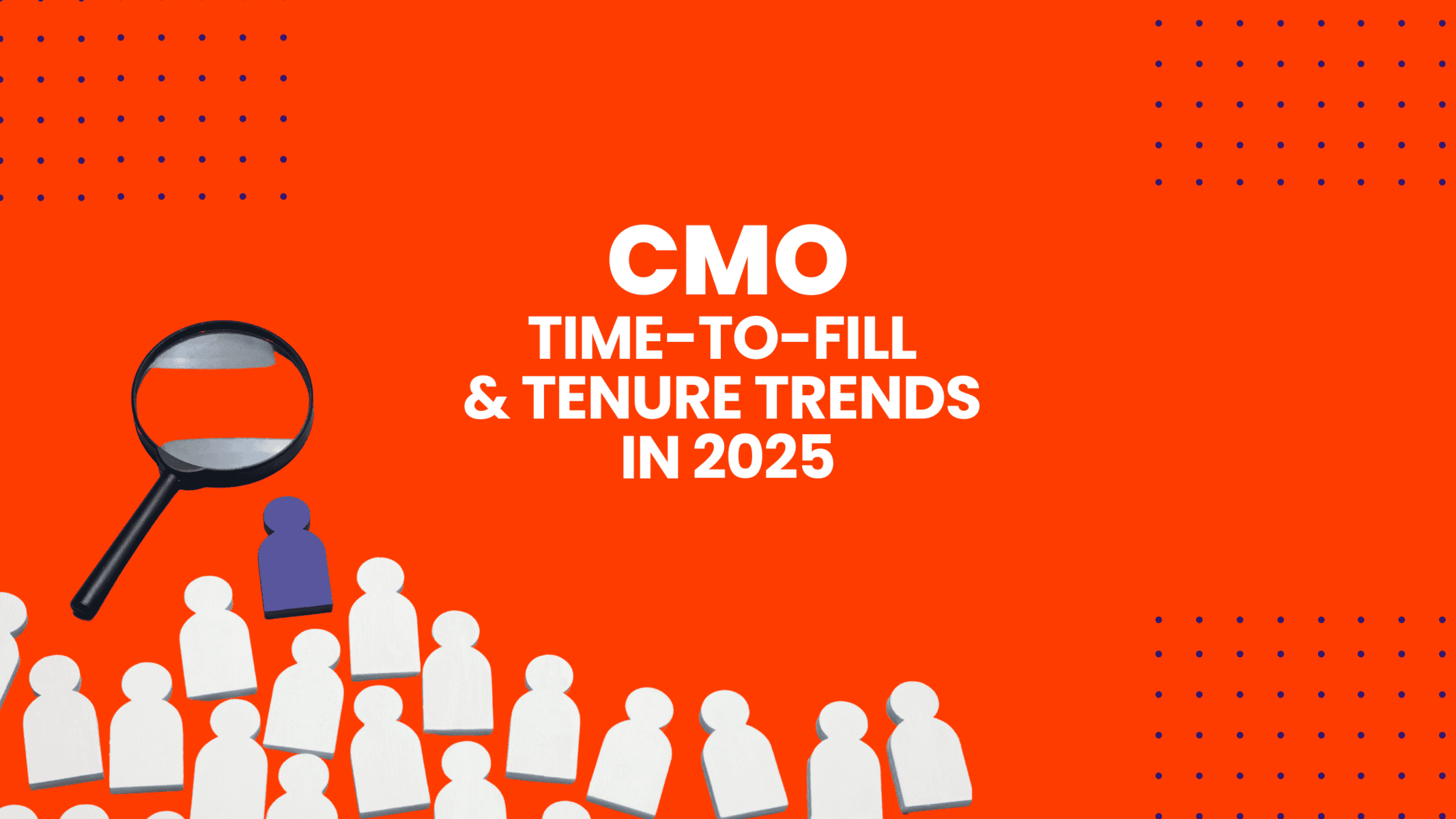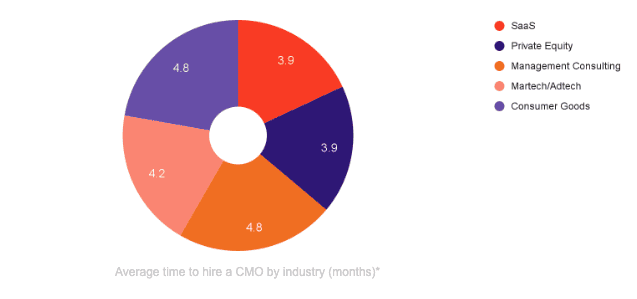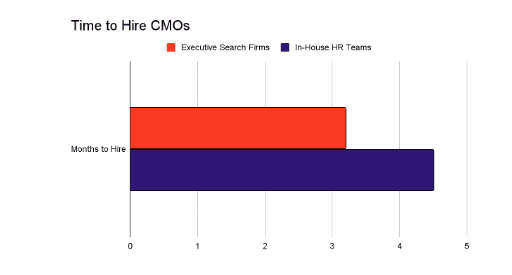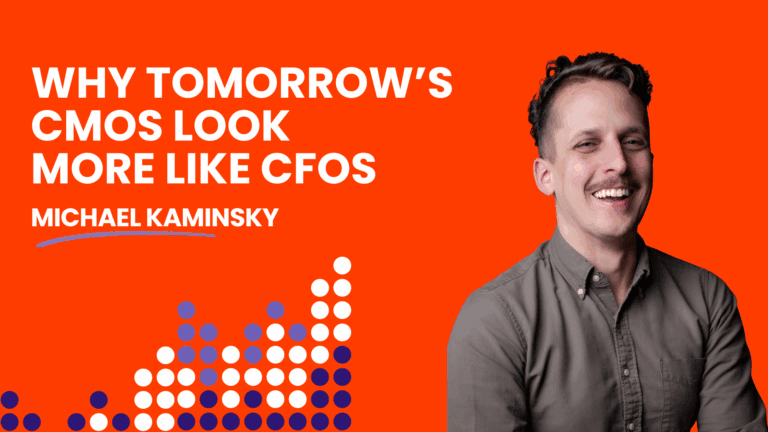In September 2025, Talentfoot analyzed 10 leading data sources to evaluate the U.S. hiring environment for Chief Marketing Officers (CMOs). The study compares CMO tenure and CMO time-to-fill against other C-suite roles, while examining the unique challenges of marketing leadership in today’s digital transformation era.
What is the Tenure of CMOs?
CMOs consistently hold shorter tenures than other C-suite executives, underscoring high expectations and rapid industry change.
Time Frame | Average CMO Tenure | Source |
2020 | 2.1 years | Forbes [1] |
2023 | 4.2 years | HBR [2] |
2024 | 2.5 years | MarketPro Inc. [3] |
2025 | 3.9 years | Forrester [4] |
Even at its five year peak (4.2 years), CMO tenure lags CEOs (6.6 years) [2,3]. A 2020 study showed the gap at its starkest—25 months for CMOs compared to 80 months for CEOs [1]. The role’s volatility raises critical questions about continuity, strategy, and retention. In fact, an HBR study found that 40% of new C-level hires leave within 2 years due to integration issues.
What is the Time-to-Fill for CMOs and Across the C-suite in 2025?
So how long does it take to hire a CMO in 2025? Well, despite shorter CMO tenures, filling these critical marketing leadership roles is often as protracted as for other C-suite positions. This paradox indicates significant recruitment investment despite retention issues. Understanding average time-to-fill for CMOs and across the C-suite provides essential context for this dynamic in the US market.
C-suite Role | Average Time-to-Fill | Source |
CMO | 3-4 months | Talentfoot [5] |
CFO | 4-5 months | Linkedin [6] |
COO | 2-3 months | |
CRO | 4-5 months | |
CEO | 4-5 months | Forbes [9] |
General C-suite | 2-3 months | Ejobsitesoftrom.com [10] |
This data reveals that despite shorter CMO tenures, recruitment time is substantial and comparable to other top executive roles. The challenge lies not just in hiring, but in integration and strategic alignment for long-term success.
What are the Factors Influencing CMO Hiring & Tenure in the US?
The paradox of significant recruitment investment versus shorter CMO tenures points to systemic issues. Several factors contribute to this discrepancy, making the CMO role uniquely challenging to fill and retain in the US.
1. The Complexity of the CMO Role Across Industry
The CMO role is constantly redefined, demanding a rare blend of skills: deep digital expertise, analytical prowess, customer experience leadership, and robust brand stewardship [7]. This complexity prolongs hiring as organizations struggle to articulate precise requirements for a modern CMO, leading to extended search times for candidates mastering this multifaceted domain [9]. Additionally, each industry has distinct CMO needs and talent pools to draw from, and as technology and AI adoption accelerate at different speeds, the average time-to-hire a CMO varies widely [5].
2. Leadership Misalignment
Most CEOs (75-85%) lack a marketing background [2], leading to misinformed perspectives and unrealistic expectations. This can result in a mismatch between the hired CMO and organizational needs, or misaligned strategic priorities. Without alignment, CMOs are set up for short-lived tenures.
3. Recruitment and Vetting Gaps
Traditional interviewing may fall short in assessing specialized skills for today’s CMO, particularly in digital transformation and data-driven decision-making [8]. This leads to inefficient vetting and difficulty identifying qualified candidates who are also a strong cultural and strategic fit. Executive search firms must continue to educate US CEOs and hiring committees on contemporary CMO demands, and implement rigorous vetting beyond conventional marketing experience.
The Business Impact of CMO Hiring Challenges
The complexities of CMO hiring and tenure have significant business consequences. Prolonged vacancies and short tenures impede strategic growth, incur substantial financial costs, and disrupt organizational stability [11].
- Vacancies delay initiatives, reduce responsiveness, impact brand positioning, and disrupt revenue growth [8]. Short tenures result in strategic discontinuity, confusing customers and demoralizing marketing teams.
- Executive searches cost 20–35% of first-year compensation [2]. Add lost revenue during vacancies and onboarding expenses, and the financial impact becomes significant.
- Frequent changes in marketing leadership signal instability, potentially eroding brand trust and reputation [2]. Inconsistent messaging and lost momentum from premature departures require new leaders to rebuild from scratch, emphasizing the value of robust recruitment and supportive environments for enduring marketing leadership
Strategies for Success: Optimizing Marketing Leadership Acquisition in the US
To overcome these challenges, US companies need a sharper approach to both recruiting and retaining CMOs:
1. Define the Role with Precision
Collaborate across HR, leadership, and marketing teams to specify the right mix of digital, brand, and growth expertise. Clear expectations streamline searches and attract the right talent.
2. Leverage Specialized Marketing Executive Search Firms
Partnering with firms like Talentfoot ensures access to deep networks, industry knowledge, and rigorous vetting. Search specialists bridge the marketing knowledge gap, improving cultural fit and reducing time-to-fill. Data analyzed by Talentfoot suggests that specialized marketing executive search firms are able to drive efficiency in the CMO hiring process compared to stand-alone in-house HR teams due to the dedicated recruiting resources they are able to apply to filling the job combined with the vetted talent pools they possess, and the sourcing technology and techniques they are able to leverage at scale [13].
3. Invest in Retention and Support
A successful hire is only the beginning. Providing authority, resources, and professional development opportunities helps transform shorter CMO tenures into long-term, impactful leadership.
Building Resilient Marketing Leadership in the US
The complex landscape of marketing leadership in the US reflects systemic issues in defining, hiring, and supporting marketing leaders. Data reveals that while organizations invest significant time in filling CMO roles, tenures are often shorter than those of their C-suite counterparts. This discrepancy stems from the rapid evolution of marketing, misalignment of expectations, and inherent recruitment challenges.
By clarifying expectations, engaging specialized search partners like Talentfoot, and investing in supportive cultures, US organizations can build resilient marketing leadership that drives sustainable growth.
Sources
- Matlins, S. (2020, July 13). CMO tenure shrank to its lowest levels since 2009: Slightly more than 25 months, compared to 80 months for CEOs. Forbes. https://www.forbes.com
- Dahlhoff, D. (2023, May 23). CMOs’ shorter tenure of 4.2 years in 2023 among Fortune 500 companies. Harvard Business Review. https://hbr.org
- MarketPro Inc. (2024, December). CMO tenure reported at 2.5 years. MarketPro Inc. https://marketproinc.com
- Forrester (2025, August). CMO Fortunes Falter Amid Economic and Role Uncertainty. Forrester. https://www.forrester.com/blogs/cmo-fortunes-falter-amid-economic-and-role-uncertainty/
- Talentfoot Executive Search (2025, September). On average it takes 3.8 months to fill a CMO role: data based on analysis of US LinkedIn job posting data + average 4 week resignation/onboarding period applied + Internal Talentfoot CMO hiring data.
- Johnson, K. W. (2024, July 18). On average it takes roughly 150 days to hire a CFO. LinkedIn. Retrieved September 20, 2025, from https://www.linkedin.com/posts/kylewaynejohnson_on-average-it-takes-roughly-150-days-to-activity-7249117114437890049-HdmM/
- Robert Stravis. (n.d.). How to hire a COO. Robert Stravis. Retrieved September 20, 2025, from https://robertstravis.com/how-to-hire-c-level-executives/how-to-hire-a-coo/
- Corporate Navigators. Average Time to Fill by Industry. https://www.corporatenavigators.com/articles/recruiting-trends/the-average-time-to-fill-by-industry-in-2024/
- Power, R. (2024, April 14). CEO role takes 149 days on average. Forbes. https://www.forbes.com
- Ejobsitesoftware.com. (2025, May 16). C-suite roles take 2–3 months on average. eJobsiteSoftware.com. https://ejobsitesoftware.com
- MarketPro Inc. (2024, December). Rapid pace of change in marketing makes CMO hiring complex. MarketPro Inc. https://marketproinc.com
- CMO Ladder. (2025, July 18). C-level job postings in the U.S. have climbed from 69 to 93, a tidy 34.8% increase year-over-year. CMO Ladder. https://cmoladder.com
- Talenfoot Executive Search (2025, September). CMO Average Time-to-Hire: derived from internal data of CMO hiring averages collected from search firms + qualitative estimates derived from HR, Talent, and Hiring Manager samples.






